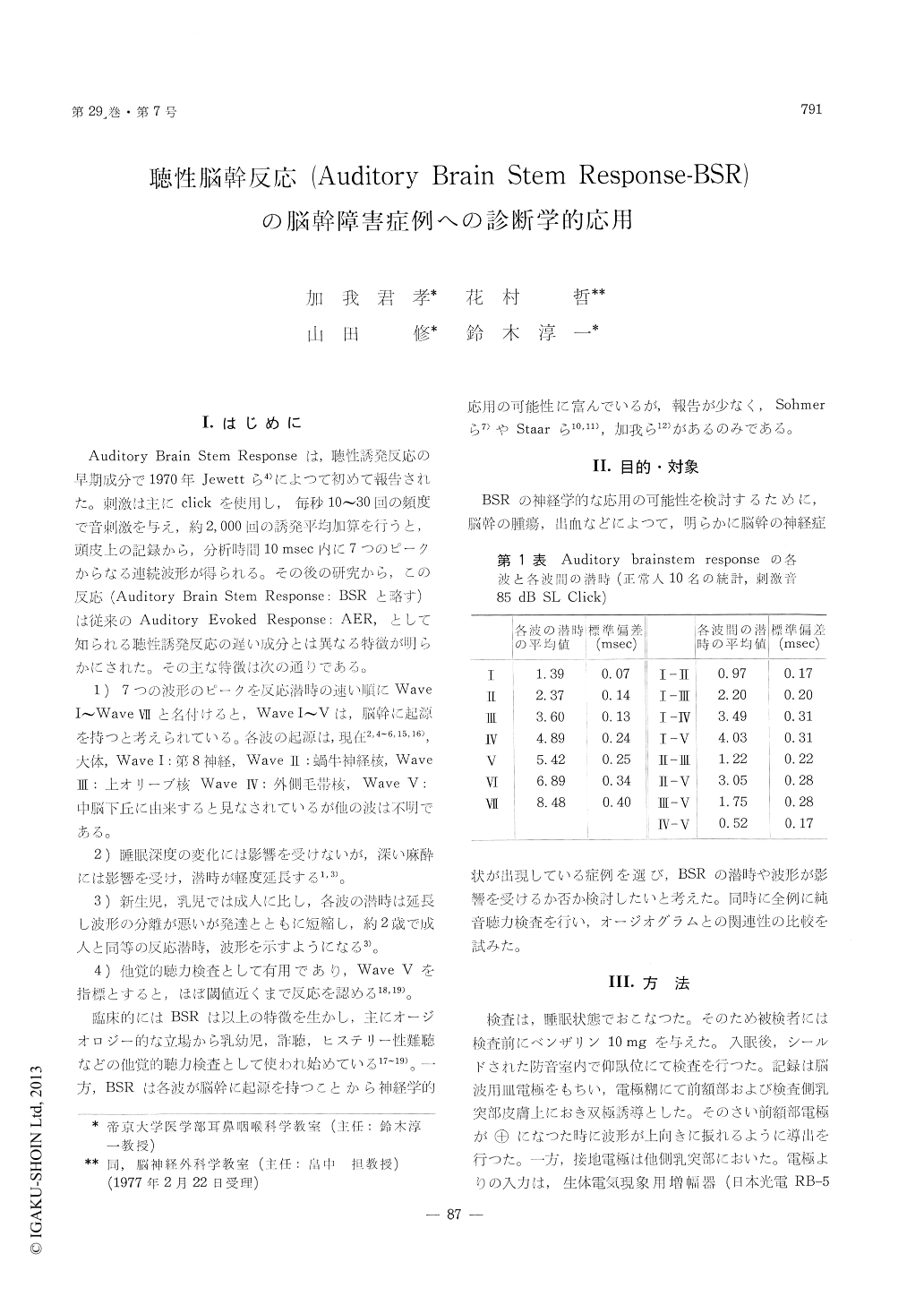Japanese
English
- 有料閲覧
- Abstract 文献概要
- 1ページ目 Look Inside
I.はじめに
Auditory Brain Stem Responseは,聴性誘発反応の早期成分で1970年Jewettら4)によつて初めて報告された。刺激は主にclickを使用し,毎秒10〜30回の頻度で音刺激を与え,約2,000回の誘発平均加算を行うと,頭皮上の記録から,分析時間10msec内に7つのピークからなる連続波形が得られる。その後の研究から,この反応(Auditory Brain Stem Response:BSRと略す)は従来のAuditory Evoked Response:AER,として知られる聴性誘発反応の遅い成分とは異なる特徴が明らかにされた。その主な特徴は次の通りである。
1)7つの波形のピークを反応潜時の速い順にWave Ⅰ〜Wave Ⅶと名付けると,Wave Ⅰ〜Ⅴは,脳幹に起源を持つと考えられている。各波の起源は,現在2,4〜6,15,16),大体,Wave Ⅰ:第8神経,Wave Ⅱ:蝸牛神経核,Wave Ⅲ:上オリーブ核Wave Ⅳ:外側毛帯核,Wave Ⅴ:中脳下丘に由来すると見なされているが他の波は不明である。
A sequence of seven low-amplitude (nanovolt) potentials that occur in the initial 10 msec follow-ing click signals can be recorded from scalp electrodes in human subjects using computer aver-aging techniques. The potentials, termed auditorybrain stem responses, are thought to be the far-field reflection of electrical events originating in the auditory pathway during its course through the brain stem. We have studied auditory brain stem responses in twelve neurological disorders of brain stem and found them to be of assistance in evaluating the localization of midbrain and brain stem tumors, the localization of demyelination of the brain stem, and the presence of diminished brain stem circulation. In particular, structural damage of the auditory brain stem pathways due to tumors, demyelination, or loss of circulation can be reflected in abnormalities of amplitude and latency of the various components. Quantitative measures of latency and amplitude of the com-ponents provide information as to the portion of the brain stem that may be abnormal.
The location of generators contributing to the auditory brain stem response has been analyzed both in experiments and in the clinical patho-logical studies. First, the latencies of the various components of the auditory brain stem response can be correlated with latencies of sound evoked potentials recorded directly from the various nuclei comprising the auditory pathway. Thus, wave Ⅰ occurs coincident with activity in Ⅷ nerve; wave Ⅱ occurs coincident with activity in cochlear nucleus; wave Ⅲ occurs coincident with activity in superior olive; waves Ⅳ and Ⅴ occur coincident with activity in the inferior colliculus.
Thus, auditory brain stem responses have certain advantages for the evaluation of the anatomical basis of neurological disease over the more classic evoked responses and pure audiometrie.
Auditory brain stem responses offer a new method of objective measurement of the deep structures of the brain that can complement the clinical evaluation.

Copyright © 1977, Igaku-Shoin Ltd. All rights reserved.


